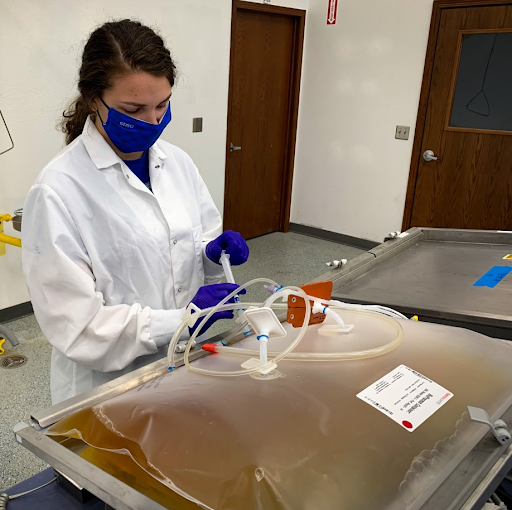
60
Agri-business

12 Oct 2020
News
As a leading immunological products and services company, Medgene Labs is at the forefront of vaccine development for the livestock production industry. Recently, the company has turned its attention to the development of a COVID-19 vaccine for companion animals and humans, with its lead candidate testing favorably in animals. The work is being done at its Brookings, South Dakota facility, made possible by recent Sioux Valley Energy’s Rural Electric Economic Development (REED) Fund loans.
“Without its support, it would have been difficult for us to get these companies started in the first place,” said Mark Luecke, CEO of Medgene Labs. “To have the REED Fund provide funding to help Medgene Labs become the first and only licensed vaccine production facility in South Dakota was a perfect demonstration of the type of partner the REED Fund is to many rural businesses trying to make a global difference.”
Medgene Labs is an Immunological Services ProviderTM to leading livestock producers. The company works with producers and veterinarians to assess herd health and the threat of emerging diseases using proprietary bioinformatics, producing prescription vaccines that specifically target the greatest health risks and assessing herd health post-vaccination to make sure the vaccines are effective.
Medgene Labs was co-founded in 2011 by South Dakota Innovation Partners and South Dakota State University (SDSU) professor Alan Young, a world-renowned immunologist. With the 2013 outbreak of Porcine Epidemic Diarrhea virus, a coronavirus that killed several million baby pigs in the United States, the company adapted its platform technology to begin working on regulatory approval for prescription vaccines with the USDA Center for Veterinary Biologics. As part of this development phase, Medgene Labs worked with Sioux Valley Energy and a second private lender to secure a REED loan to purchase land, construct two buildings and purchase equipment to produce the vaccines. Upon completion and USDA inspection, these buildings became South Dakota’s first and only government-licensed vaccine production facilities.
The company has recently leveraged its platform technology and previous experience in producing animal coronavirus vaccines to develop a companion animal and human COVID-19 vaccine. As a result, Medgene Labs has tested its COVID-19 vaccine candidate in pre-clinical studies as part of the overall regulatory process. Developing vaccines for both animals and humans is an important path to follow, said Luecke.
“It is widely recognized that animals serve as a potential reservoir for viruses, such as COVID-19, to reside and potentially change their genetic structure in ways that will make current vaccines irrelevant,” he said. “Therefore, we need an animal vaccine for species that could serve as a potential host for COVID-19.”
Recently, Science Magazine reported there was strong evidence of animal-to-human transmission of COVID-19 on mink farms in the Netherlands. Denmark has announced that it will cull 1 million mink due to infections on its farms. The U.S. Department of Agriculture has been tracking confirmed cases of COVID-19 in animals, which has included cats and dogs. Cats in particular have been shown by Colorado State University to be highly susceptible to COVID-19 infection.
The company is currently in discussions with a number of partners that have an interest in bringing the vaccine forward for human use.
“It is exciting to think that our regional partnership with Sioux Valley Energy and others could lead to an effective vaccine for COVID-19 that allows people to stay at work,” said Luecke.
A platform technology and approach to helping leading livestock producers and the industry allows Medgene Labs to develop and deliver new vaccines for emerging diseases in a matter of days or weeks as opposed to years. One example is a current project with the USDA to rapidly develop a vaccine for rabbit hemorrhagic disease, a foreign animal disease currently affecting the nation’s rabbit population. The company’s approach focuses on protection in order to prevent the economic loss of disease before it occurs and proving that its vaccines are effective in the field by following up with testing post-vaccination.
“Livestock producers want to know they are getting the protection that they are paying for and Medgene Labs demonstrates that for them,” said Luecke.
As the company searched for the expansion provided through the REED funding, Brookings easily stood out as home to SDSU and the state’s Animal Disease Research and Diagnostic Laboratory. More importantly, according to Luecke, the community supports its entrepreneurs like none other. The company is part of South Dakota Innovation Partners’ portfolio of companies which have invested over $200 million of capital in Brookings County over the last five years.
“South Dakota Innovation Partners has a long-standing relationship with Brookings Economic Development Corporation, receiving early support to start companies based on university research,” said Luecke. “That support has continued in various ways through each of the development stages that Medgene Labs has completed.”
Today, with the addition of the buildings and equipment put into service over the last few years, Medgene Labs plans to expand further within the next two years. The company has grown to over 20 employees in technology-based jobs and includes many SDSU graduates. In light of the COVID-19 crisis, their work goes well beyond protecting livestock, seeking ways to benefit society in general.
“Livestock producers and other animal owners will benefit from the companion animal vaccine to protect their animals from the disease and prevent a virus reservoir from occurring,” said Luecke. “Nations and their citizens throughout the world will benefit from a human vaccine by preventing the transmission of disease, allowing populations to return to health and economies to return to positive growth.”


